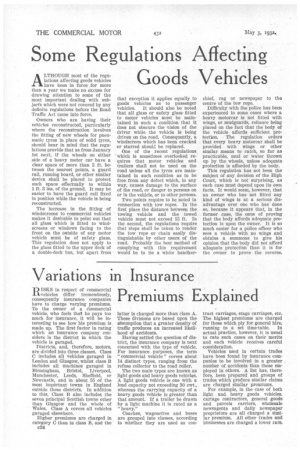Some Regulations Affecting Goods Vehicles
Page 134

If you've noticed an error in this article please click here to report it so we can fix it.
ALTHOUGH most of the regulations affecting goods vehicles have been in force for more than a year we make no excuse for drawing attention to some of the most important dealing with subject's which were not covered by any definite regulations before the Road Traffic Act came into force.
Owners who are having their vehicles reconstructed, particularly where the reconstruction involves the fitting of new wheels for pneumatic tyres in place of solid tyres, should bear in mind that the regulations provide that as from January 1st next, if the wheels on either side of a heavy motor car have a clear space of more than 2 ft. between the nearest points, a guard rail, running board, or other similar device shall be placed to protect such space effectually to within 1 ft. 3 ins, of the ground. It may be easier to have the guard rail fixed in position while the vehicle is being reconstructed.
The increase in the fitting of windscreens to commercial vehicles makes it desirable to point out that all glass which is fitted to windscreens or windows facing to the front on the outside of any motor vehicle must be of safety glass. This regulation does not apply to the glass fitted to the upper deck of a double-deck bus, but apart from that exception it applies equally to goods vehicles as to passenger vehicles. It should also be noted that all glass or safety glass fitted to motor vehicles must be maintained in such a condition that it does not obscure the vision of the driver while the vehicle is being driven on the road. Consequently, a windscreen which has been cracked or starred should be replaced.
One of the recent regulations which is sometimes overlooked requires that motor vehicles and trailers shall not be used on the road unless all the tyres are maintained in such condition as to be free from any defect which, in any way, causes damage to the surface of the road, or danger to persons on or in the vehicle, or to other persons.
Two points require to be noted in connection with tow ropes. In the first place the distance between the towing vehicle and the towed vehicle must not exceed 15 ft. In the second, the regulations require that steps shall be taken to render the tow rope or chain easily distinguishable by other users of the road. Probably the best method of complying with this requirement would be to tie a white handker
chief, rag or newspaper to the centre of the tow rope.
Difficulty with the police has been experienced in some eases where a heavy motorcar is not fitted with wings, or mudguards, reliance being placed on the fact that the body of the vehicle affords sufficient protect'ion. The regulation orders that every heavy motorcar shall be provided with wings or other similar means to catch, so far as practicable, mud or water thrown up by the wheels, unless adequate protection is afforded by the body.
This regulation has not been the subject of any decision of the High Court, which is not surprising, as each case must depend upon its own facts. It would seem, however, that an owner who has not fitted any kind of wings is at a serious disadvantage over one who has done so, because it appears that, in the former case, the onus of proving that the body affords adequate protection is upon the owner. It is so much easier for a police officer who sees a vehicle with no wings and obtains a summons to give his opinion that the body did not afford adequate protection than it is for the owner to prove the reverse.
















































































































































































